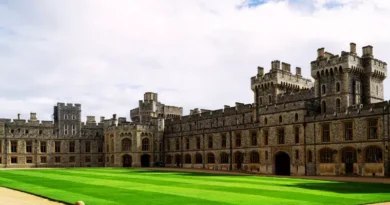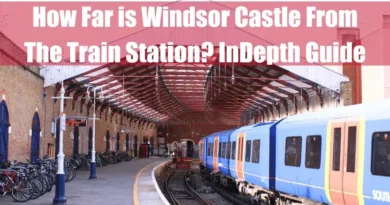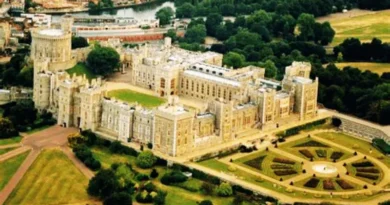Get to Windsor Castle From Salford
Key Points
- Windsor Castle is approximately 204 miles (328 kilometres) from Salford via the M6 and M40 or about 215 miles (346 kilometres) via the M1.
- By car, the quickest and most direct option is via the M6 and M40, taking around 3 hours and 15 minutes and covering approximately 204 miles (328 km); this route avoids the M6 Toll and provides a smooth transition through the M42, M40, and M4 before reaching Windsor.
- Alternatively, a longer route via the M1 and M25 takes about 3 hours and 33 minutes but may be preferable if there are delays on the M6.
- By train, the fastest and most convenient route is via Manchester Piccadilly, Reading, and Slough, followed by a GWR service to Windsor & Eton Central and a short walk to the Castle, typically taking about 4 hours and 38 minutes with efficient transfers.
- Other rail routes via York, Doncaster, or Sheffield are longer and involve more changes, often including travel through London.
- For cycling enthusiasts, three long-distance routes are available, the most accessible being a 205-mile route combining National Cycle Routes 55 and 5, offering a flatter profile and estimated cycling time of nearly 18 hours.
- The train offers the most balanced combination of comfort, accessibility, and time efficiency, particularly for those seeking a stress-free journey without navigating congested roads or undertaking a demanding ride.
🚗 Travelling by Car from Salford to Windsor Castle
| Route | Estimated Time | Distance (miles / km) | Motorways / Roads Used | Notes |
|---|---|---|---|---|
| Via M6 & M40 | 3 hr 15 min | 204 mi / 328 km | M602, M62, M6, M5, M42, M40, A404(M), M4 | Fastest route; bypasses M6 Toll; some parts may have closures. |
| Via M1 | 3 hr 33 min | 215 mi / 346 km | M602, M62, M6, A500, A50, M1, M25, M4 | Slightly longer; may be preferred if M6 has roadworks or congestion. |
🚆 Travelling by Train from Salford to Windsor Castle
| Route | Approx. Time | Main Connections | Changes | Notes |
|---|---|---|---|---|
| Via Manchester Piccadilly – Reading – Slough (Option A) | 4 hr 38 min | Salford Crescent, Piccadilly, Reading, Slough | 3 train changes | Fastest and most direct; walk from Windsor & Eton Central to Castle. |
| Via Manchester Piccadilly – Reading – Slough (Option B) | 4 hr 46 min | Same as above, ends with bus to Windsor | 3 train + 1 bus | Slightly longer due to bus segment to Windsor Parish Church. |
| Via York – King’s Cross – Paddington – Slough | 4 hr 59 min | Victoria, York, King’s Cross, Paddington, Slough | 4 train + Tube | Scenic; includes Underground transfer in London. |
| Via Doncaster – King’s Cross – Paddington – Slough | 5 hr 9 min | Piccadilly, Doncaster, King’s Cross, Paddington | 4 train + Tube | Longer intercity segments; more transfers; potentially delayed in London peak hours. |
| Via Sheffield – St Pancras – Paddington – Slough | 5 hr 9 min | Piccadilly, Sheffield, St Pancras, Paddington | 4 train + Tube | Similar to Doncaster route; includes East Midlands line; longer walking sections. |
🚴 Travelling by Bicycle from Salford to Windsor Castle
| Route | Distance | Estimated Time | Terrain / Elevation | Highlights |
|---|---|---|---|---|
| National Route 68 (Pennine Way) | 215 mi / 346 km | 19 hr 3 min | Hilly; +5,194 ft / -5,223 ft | Pennine landscapes, Derbyshire Dales, traffic-free trails like Tissington Trail |
| National Cycle Route 5 | 220 mi / 354 km | 19 hr 29 min | Mixed; +4,915 ft / -4,948 ft | Passes Oxford, Birmingham, Chester; cultural landmarks along Thames Valley |
| Route 55 & 5 Combination | 205 mi / 330 km | 17 hr 58 min | Flatter; +4,209 ft / -4,242 ft | Through Telford, Stafford, Macclesfield; relaxed terrain, scenic railway paths |
Getting to Windsor Castle from Salford by Car
Route 1: (Via M6 and M40)
One of the most direct and efficient routes from Salford to Windsor Castle is via the M6 and M40 motorways. This journey typically takes around 3 hours and 15 minutes, covering a distance of approximately 204 miles (328 kilometres) under usual traffic conditions. This is the fastest option, bypassing road closures on the M6 Toll.
Departure from Salford:
- Start by heading west towards Fitzwarren Street.
- Exit the roundabout onto Fitzwarren Street and continue for 0.3 miles.
- Turn left onto Liverpool Street, driving for 0.5 miles.
- Turn right onto Albion Way (A5063) and continue for 0.2 miles.
- Use the right lane to continue on Regent Road Roundabout, then turn right onto Regent Road (A57) and continue for 479 feet.
Joining the Motorway Network:
- Continue onto the M602, following signs for Ring Road / M60 / Liverpool / M62 (4.2 miles).
- Merge onto the M62 (8.0 miles).
- Use the left lane to take the M6 S / M6 N exit toward Birmingham / Chester / M56 / Preston (0.3 miles).
- Take a slight left onto the M6(S) South ramp to Birmingham (0.9 miles).
- Use the right lane to take the ramp onto the M6 (60.1 miles).
Continuing South:
- At junction 11A, use the left two lanes to take the M6 exit to Birmingham / M5 (0.8 miles).
- Continue on the M6, following signs for Birmingham S / M5 SW (5.9 miles).
- Keep right to stay on the M6 (3.1 miles).
- At junction 8, take the M5 exit to Birmingham (West) / Birmingham (South) / West Bromwich (1.5 miles).
- Continue onto the M5 (14.8 miles).
Transition to M40:
- Take the M42 exit toward London / M40 / N.E.C. & Airport (0.6 miles).
- Use the right lane to take the ramp onto the M42 (10.9 miles).
- Keep right to continue on the M40, following signs for London / Warwick / Stratford (74.3 miles).
Joining A404 and M4:
- At junction 4, take the A404 exit to High Wycombe / Marlow / M4 / Maidenhead (0.3 miles).
- Use the right two lanes to take the ramp to A404 (230 feet).
- Take the 2nd exit onto A404 (4.4 miles) at Handy Cross Roundabout.
- At the next roundabout, take the 3rd exit and stay on A404 (3.0 miles).
- Keep right to continue on A404(M), following signs for Reading / Slough / Windsor / M4 (2.5 miles).
- Use the middle lane to turn slightly left onto Holyport Interchange (322 feet).
- Take the M4 exit toward London (0.2 miles).
- Slight right to merge onto the M4 (4.4 miles).
- Take the exit toward A355 (0.3 miles).
Final Approach to Windsor:
- At the roundabout, take the 3rd exit onto A355 (0.5 miles).
- Continue onto Royal Windsor Way (A332) (1.2 miles).
- Slight left onto Clarence Road and go through 1 roundabout (0.5 miles).
- Continue onto Victoria Street (0.3 miles).
- At the roundabout, take the 1st exit onto Sheet Street (B3022) and continue to follow B3022 (0.2 miles).
Note: Parts of this road may be closed at certain times or days.
- Turn right onto Castle Hill (266 feet), where you will arrive at your destination: Windsor Castle.

Route 2: (Via M1)
An alternative to the M6/M40 route is travelling from Salford to Windsor Castle via the M1 motorway. This journey is slightly longer, taking around 3 hours and 33 minutes, and spans a distance of approximately 215 miles (346 kilometres) under normal traffic conditions. Depending on traffic or roadworks on the M6 corridor, this route may be preferred.
Leaving Salford:
- Begin by heading west toward Fitzwarren Street.
- Exit the roundabout onto Fitzwarren Street (0.3 miles).
- Turn left onto Liverpool Street and continue for 0.5 miles.
- Turn right onto Albion Way (A5063) (0.2 miles).
- Use the right lane to continue on Regent Road Roundabout, then turn right onto Regent Road (A57) (479 feet).
Joining M602, M62, and M6:
- Continue onto the M602, following signs for Ring Road / M60 / Liverpool / M62 (4.2 miles).
- Merge onto the M62 (8.0 miles).
- Take the M6 S / M6 N exit toward Birmingham / Chester / M56 / Preston (0.3 miles).
- Take the M6(S) South ramp to Birmingham (0.9 miles).
- Merge onto the M6 (36.7 miles).
- At junction 15, take the A500 exit to Stoke-on-Trent / Stone / Derby / A50 (0.4 miles).
Crossing into the East Midlands:
- At Hanchurch Interchange, take the 2nd exit onto Queensway (A500) (1.7 miles).
- Use the left 2 lanes to take the ramp to Campbell Road / Derby / Uttoxeter (A50) (0.1 miles).
- Use the right 2 lanes to take the A50 ramp (0.3 miles).
- Take the 2nd exit onto A50 at Sideway and continue for 6.0 miles.
- At Tean Roundabout, take the 2nd exit and stay on A50 (8.6 miles).
- At McDonald’s Roundabout, take the 2nd exit onto Uttoxeter Bypass (A50) (0.9 miles).
- At Derby Road Roundabout, take the 2nd exit onto Doveridge Bypass (A50) (4.7 miles).
- At Sudbury Roundabout, take the 2nd exit onto Foston – Hatton – Hilton Bypass (A50) and continue along the A50 for 19.6 miles.
- Use the right lane to take the M1 South / A50 ramp to Leicester / Nottingham (S) / East Midlands Airport (0.6 miles).
- Take the M1(S) ramp to London / Leicester / Loughborough (0.4 miles).
Heading South on the M1 and M25:
- Merge onto the M1 (18.8 miles).
- Keep right to stay on the M1 for a further 75.9 miles.
- At junction 6A, use the 3rd lane from the left to take the M25 exit to M40 / M4 / Heathrow Airport (0.8 miles).
- Use the right lane to take the ramp onto the M25 (18.8 miles).
- At junction 15, use the left 2 lanes to merge onto the M4 toward Slough (2.2 miles).
- Take the A4 exit toward Colnbrook / B470 / Datchet / Langley (0.3 miles).
Final Approach to Windsor:
- At Langley Roundabout, take the 2nd exit onto Major’s Farm Road (B470) (1.7 miles).
- At the next roundabout, take the 2nd exit onto London Road (B376 / B470) (210 feet).
- At the following roundabout, take the 1st exit onto High Street (B470) (0.2 miles).
- Turn right onto Windsor Road (B470) and continue for 1.4 miles.
- Turn left onto Thames Street (B3022).
Note: Parts of this road may be closed at certain times or days.
- Turn left onto Castle Hill (266 feet) and arrive at Windsor Castle.
Getting to Windsor Castle from Salford by Train
Travelling from Salford to Windsor Castle by train involves several route options, each with varying travel times, connection points, and changes. The journey generally takes between 4 hours 37 minutes and 5 hours 9 minutes, depending on the route taken, connection timings, and chosen mode of onward travel within Berkshire.
Overview of Routes and Journey Times
There are five primary rail routes from Salford Crescent to Windsor Castle, differing in travel duration, transfer frequency, and complexity. The key reason for the variation in journey times lies in the number of transfers, length of layovers, and the use of alternative public transport (e.g., bus or tube) for part of the journey. All routes end with either a short walk or a local connection to reach Windsor Castle from the nearest railway station.
Route 1: Via Manchester Piccadilly, Reading, and Slough (4 hr 38 min – 4 hr 46 min)
- Fastest and most direct of all routes, with minimal walking and consistent connections.
- Begins at Salford Crescent with a short local train to Manchester Piccadilly, followed by a CrossCountry service to Reading.
- From Reading, the Elizabeth Line train to Slough is used.
- From Slough, two options:
- Option A: A GWR train directly to Windsor & Eton Central, followed by a short 7-minute walk to the Castle. Total journey: approximately 4 hr 38 min.
- Option B: Alternatively, one may take a local bus (route 8) from Slough to Windsor Parish Church and walk from there. This adds some waiting and results in a slightly longer journey of about 4 hr 46 min.
This route is optimal for simplicity, with only three main train changes and minimal waiting times between transfers.
Route 2: Via York, King’s Cross, and Paddington (4 hr 59 min)
- Starts with a short Northern train to Manchester Victoria, followed by a TransPennine Express to York, and then a non-stop Grand Central train to London King’s Cross.
- A brief walk leads to King’s Cross St. Pancras Underground Station, where the Hammersmith & City or Circle Line takes passengers to London Paddington.
- From Paddington, a GWR train to Slough, and then the usual short GWR shuttle to Windsor & Eton Central, ending with a walk to the Castle.
This route, while scenic and potentially less crowded, takes slightly longer due to the use of both long-distance rail and London Underground connections.
Route 3: Via Doncaster, London King’s Cross, and Paddington (5 hr 9 min)
- Begins with a Northern train to Manchester Piccadilly, followed by a TransPennine Express service to Doncaster.
- From Doncaster, a direct LNER train to London King’s Cross, then a subway journey to Paddington, and from there, trains follow the standard route via Slough to Windsor.
- This route includes multiple changes and a longer intercity leg, accounting for the increased journey time.
- Delays can occur if inter-station transfers within London are prolonged, especially during peak hours.

Route 4: Via Sheffield, London St Pancras, and Paddington (5 hr 9 min)
- Starts similarly to Route 3 but includes a TransPennine Express to Sheffield, then an East Midlands Railway (EMR) train to St Pancras International.
- Again, travellers must switch to the Underground at King’s Cross St. Pancras, ride to Paddington, and proceed via Slough to Windsor.
- The total duration is extended primarily due to the longer intercity segments and more substantial walking intervals between stations.
Route 5: Departure via Reading and Slough (4 hr 37 min)
- Essentially a later version of Route 1, departing from Salford Crescent around midday.
- This route includes the same sequence: Northern train to Manchester Piccadilly, CrossCountry to Reading, Elizabeth line to Slough, and final GWR link to Windsor & Eton Central.
- Travel time remains competitive at around 4 hr 37 min but may involve slightly longer waiting periods at Reading and Slough, depending on off-peak service frequency.
Summary of Travel Time Differences
| Route | Approx. Journey Time | Key Reason for Duration |
|---|---|---|
| Manchester Piccadilly – Reading – Slough | 4 hr 37–46 min | Efficient transfers, high-speed mainline trains |
| York – London – Slough | 4 hr 59 min | More changes, Underground transfer in London |
| Doncaster – London – Slough | 5 hr 9 min | More stops, longer intercity leg, transfers |
| Sheffield – St Pancras – Slough | 5 hr 9 min | Several changes, longer walking/transfers |
| Midday Route via Reading | 4 hr 37 min | Similar to Route 1, but potentially longer waits |
Final Note
The quickest and most convenient route from Salford to Windsor Castle is generally via Manchester Piccadilly, Reading, and Slough, with an approximate journey time of 4 hours 38 minutes, especially when all transfers align smoothly. Routes involving London King’s Cross or St Pancras introduce more complexity and time due to longer intercity legs, Underground navigation, and increased walking times. Travellers are encouraged to consider the balance between convenience, comfort, and flexibility based on their departure time.
Cycling Routes from Salford to Windsor Castle
Embarking on a cycling journey from Salford to Windsor Castle offers a unique opportunity to traverse England’s diverse landscapes and historic towns. Below are three notable routes, each with its own distinct characteristics, challenges, and points of interest.
Route 1: National Cycle Route 68 (Pennine Cycleway)
- Distance & Duration: Approximately 215 miles; estimated cycling time of 19 hours and 3 minutes.
- Elevation Gain/Loss: 5,194 ft ascent / 5,223 ft descent.
- Terrain: Predominantly hilly with significant climbs and descents.
- Access Notes: Includes sections with restricted usage or private roads.
Highlights:
- South Pennines: Experience a variety of landscapes, including canal embankments, historic textile mills, market towns, pastoral farmland, and open moorlands.
- Derbyshire Dales: Cycle through picturesque villages and market towns, with views of wooded valleys, rugged crags, and sparkling rivers.
- Traffic-Free Trails: Enjoy the Mickleover Greenway, Tissington Trail, Midshires Way north of Buxton, and the Longdendale Trail
Considerations:
- The route’s hilly nature may be challenging for some cyclists.
- Be prepared for sections with restricted access or private roads.
Route 2: National Cycle Route 5
- Distance & Duration: Approximately 220 miles; estimated cycling time of 19 hours and 29 minutes.
- Elevation Gain/Loss: 4,915 ft ascent / 4,948 ft descent.
- Terrain: Moderate with a mix of on-road and traffic-free sections.
- Access Notes: Includes sections with restricted usage or private roads.
Highlights:
- Historic Towns: Pass through Oxford, Stratford-upon-Avon, Birmingham, and Chester, each rich in history and culture.
- Scenic Countryside: Enjoy the beautiful British countryside, including the Thames Valley and North Wales Coast.
- Cultural Landmarks: Explore UNESCO World Heritage sites and other notable landmarks along the route.
Considerations:
- The route offers a balance of urban and rural cycling experiences.
- Be aware of sections with restricted access or private roads.
Route 3: National Routes 55 and 5 Combination
- Distance & Duration: Approximately 205 miles; estimated cycling time of 17 hours and 58 minutes.
- Elevation Gain/Loss: 4,209 ft ascent / 4,242 ft descent.
- Terrain: Generally flatter, making it the most accessible of the three routes.
- Access Notes: Includes sections with restricted usage or private roads.
Highlights:
- Route 55: Travel through Telford, Newport, Stafford, Macclesfield, Stockport, and Wigan or Bolton. Notable sections include the Biddulph Valley Way, a scenic path along a disused railway line.
- Route 5: Connects with Route 5, allowing access to the historic towns and countryside described in Route 2.
Considerations:
- This route offers a more relaxed cycling experience with fewer elevation changes.
- Ideal for cyclists seeking a balance between distance and terrain difficulty.
Approaching Windsor Castle
As you near your destination, consider exploring the scenic cycling routes around Windsor and Maidenhead. Notable areas include Windsor Great Park and the Jubilee River, offering tranquil settings and picturesque views. Additionally, National Route 4, known as the Thames Valley Cycle Route, passes through Windsor Great Park, providing a scenic approach to the Castle.
Embarking on this cycling journey offers a physical challenge and an enriching experience through England’s diverse landscapes and historic locales. Choose the route best suits your preferences and enjoy the ride to Windsor Castle.









